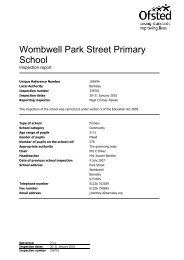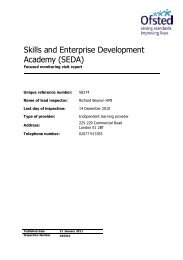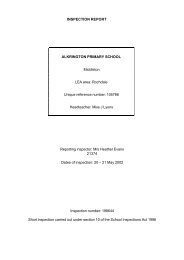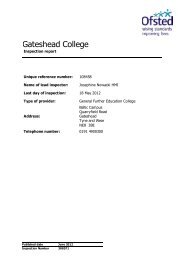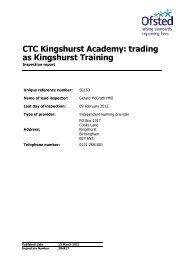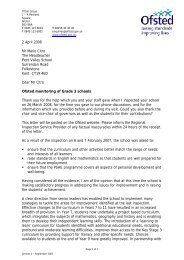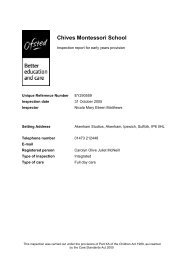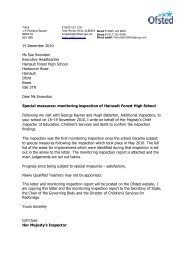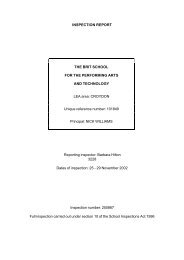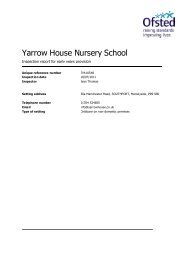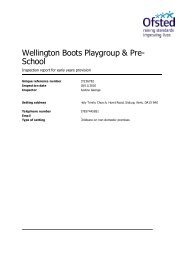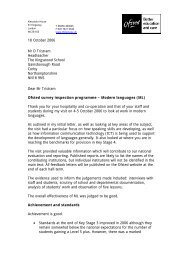pdf Section 3 inspection report - Ofsted
pdf Section 3 inspection report - Ofsted
pdf Section 3 inspection report - Ofsted
You also want an ePaper? Increase the reach of your titles
YUMPU automatically turns print PDFs into web optimized ePapers that Google loves.
Institutional Inspections and Frameworks Division<br />
4 th Floor<br />
Alexandra House<br />
33 Kingsway<br />
London<br />
WC2B 6SE<br />
26 May 2005<br />
Mr T Westrip<br />
Acting Headteacher<br />
Hainault Forest High School<br />
Harbourer Road<br />
Hainault<br />
Ilford<br />
Essex IG6 3TN<br />
Dear Mr Westrip<br />
Direct Tel 020 7421 6594<br />
Direct Fax 020 7421 6855<br />
www.ofsted.gov.uk<br />
Implementation of Hainault Forest High School's Action Plan<br />
Following the visit of David Jones HMI, Carmen Rodney HMI, Tina Herring HMI and<br />
Terry Turner, Additional Inspector to your school on 11 and 12 May 2005, I write<br />
on behalf of Her Majesty's Chief Inspector to confirm the <strong>inspection</strong> findings which<br />
are recorded in the attached note.<br />
The visit was the fourth monitoring <strong>inspection</strong> since the school became subject to<br />
special measures. The focus of the <strong>inspection</strong> was to assess: the pupils' standards<br />
of attainment and their progress; the quality of education provided; the leadership<br />
and management of the school; the pupils' attitudes and behaviour; and the<br />
progress that has been made in implementing the action plan.<br />
The school has made reasonable progress since the last monitoring <strong>inspection</strong> and<br />
limited progress overall since being subject to special measures.<br />
The school may appoint newly qualified teachers.<br />
I am copying this letter and the note of the <strong>inspection</strong> findings to the Secretary of<br />
State, the chair of governors, the Interim Director of Children's Services for<br />
Redbridge and DfES Specialist School <strong>Section</strong>. This letter will be posted on the<br />
<strong>Ofsted</strong> website.<br />
Yours sincerely<br />
Andrew Reid<br />
Head of Institutional Inspections and Frameworks Division
IMPLEMENTATION OF HAINAULT FOREST HIGH SCHOOL'S ACTION PLAN<br />
Findings of the fourth monitoring <strong>inspection</strong> since the school became subject to<br />
special measures<br />
During the visit 39 lessons or parts of lessons, two registration sessions and<br />
one assembly were inspected. Meetings were held with the headteacher, the chair<br />
of governors, representatives of the LEA and nominated staff. Informal discussions<br />
were held with other members of staff and with pupils and samples of work were<br />
examined. A range of documents was scrutinised. Using this evidence, HMI made<br />
the following observations to the headteacher, the chair of the governing body, a<br />
representative from the LEA, and the headteacher designate.<br />
The school has produced a revised action plan that presents a focused set of<br />
actions and success indicators designed to achieve and measure progress in the<br />
identified areas for improvement. The plan provides a clear basis for school<br />
improvement, includes suitable milestones, has been shared appropriately with<br />
staff and governors and provides a sound basis for future developments.<br />
The 2004 test and examination data was reviewed in the previous note of<br />
<strong>inspection</strong> findings; however, the recently validated results indicate some areas of<br />
improvement. The results of the 2004 Key Stage 3 tests in English were in line<br />
with schools nationally; however, those for mathematics and science were below<br />
the average. The proportions of the pupils achieving the higher Level 6 were in<br />
line with national figures in English and science but below the national average in<br />
mathematics. At Key Stage 4, the proportion of pupils attaining five or more<br />
grades A* to C at GCSE improved slightly to 41 per cent. The figures were above<br />
those of schools where the pupils’ prior attainment was similar although below the<br />
national average. However, the results of middle and lower achieving pupils were<br />
revised to a lower level by the validation process. During this <strong>inspection</strong> standards<br />
in lessons were below those expected for the age of the pupils in 21 lessons; they<br />
were above expectations on five occasions.<br />
Standards of literacy have not changed significantly since the previous <strong>inspection</strong><br />
and remain unsatisfactory overall. The use of informal and colloquial language<br />
reduces the quality of the pupils’ oral and written answers and their creative<br />
responses. Displays of work show a range of writing some of which includes the<br />
use of complex sentences and powerful vocabulary. However, the pupils’ use of<br />
punctuation is poor. The teachers regularly accept work which is clearly below the<br />
pupils’ level of ability. The pupils lack experience in reviewing their own work; not<br />
enough emphasis is placed on redrafting and editing skills. When required to write<br />
the pupils do not make sufficient references to the relevant text to substantiate<br />
their responses. During the <strong>inspection</strong> the quality of provision varied from good to
unsatisfactory. The appointment of a permanent and competent head of<br />
department has begun to provide subject expertise and professional guidance in<br />
the teaching of English.<br />
Standards of achievement in mathematics at Key Stage 3 are improving,<br />
particularly amongst the more able pupils. However, there are still too many<br />
occasions when pupils are insufficiently challenged and the work is targeted<br />
towards the median pupil in the group. The 2005 departmental targets for the<br />
National Curriculum tests and GCSE are challenging and aim to build on recent<br />
improvements. The number of students continuing with mathematics post-16 has<br />
improved significantly this year. Teachers are now more systematic in their use of<br />
assessment to inform learning and pupils often receive instant feedback on their<br />
progress. The quality of provision in mathematics is sound overall.<br />
Standards of attainment in science are improving and the quality of provision is<br />
sound. A good example was seen in Year 11 of higher ability pupils being<br />
challenged to explain their understanding of particle physics. Although resources<br />
and displays are generally of a high standard, much greater use should be made of<br />
information and communication technology (ICT), particularly in the sixth form.<br />
The quality of teaching remains unsatisfactory overall; however, the proportion of<br />
satisfactory teaching has increased. The teaching was at least satisfactory in<br />
30 lessons, including 12 in which it was good or better. Although the proportion of<br />
very good teaching had fallen slightly, excellent teaching was observed for the first<br />
time. Teaching was unsatisfactory in seven lessons and poor in two. The quality<br />
of teaching varied between the key stages. It was good in Key Stage 4,<br />
unsatisfactory in Key Stage 3 and adequate at Key Stage 5. Good and better<br />
lessons were seen in English, mathematics, science, modern foreign languages,<br />
law, history, geography, art, drama and music. Unsatisfactory and poor lessons<br />
were seen in English, mathematics, science, design technology, geography and art.<br />
Very good teaching was observed in music, and excellent teaching in history.<br />
Some teachers are introducing new initiatives and raising standards but in too<br />
many lessons the school’s standard procedures for lessons were not consistently<br />
followed. The experienced teachers who do not implement the agreed strategies<br />
disadvantage other colleagues who try to implement the school system.<br />
The common features of the most successful lessons were similar to those noted in<br />
previous monitoring letters. Effective lessons began at the classroom door where<br />
pupils were greeted and quickly directed into a formal activity. The teachers made<br />
good use of open questions to engage the pupils, assess their understanding and<br />
address misconceptions. The lessons were conducted at a brisk pace and the<br />
pupils’ interest was engaged by the appropriate level of challenge, a stimulating<br />
range of activities and good use of resources. Some of these lessons were
structured carefully to include opportunities for assessment by both the teachers<br />
and the pupils. The teachers used praise effectively and it was appropriate to the<br />
pupils work and effort. Relationships between the adults and the pupils were<br />
positive, polite and relaxed so that even the most reluctant pupils were won over.<br />
In the best lessons the pupils understood how the new learning related to previous<br />
work, what was expected of them, and how their learning could be expected to<br />
develop.<br />
Unsatisfactory lessons continue to be heavily but not entirely dominated by<br />
behavioural issues and some unsatisfactory behaviour is directly related to the slow<br />
pace of teaching and inappropriate level of challenge. Too often a laborious start<br />
to a lesson was followed by unchallenging and poorly planned work. The<br />
unsatisfactory level of intellectual challenge enabled some able and average pupils<br />
to be disruptive for most of the lesson; however, these pupils escaped detention<br />
because they were able to complete the task in the last few minutes of the lesson.<br />
The quality of lesson planning has improved and is sound. The identification of the<br />
pupils with additional needs is a positive development. When included, lesson<br />
objectives were usually appropriate; however, these are frequently omitted from<br />
lesson plans and consequently not consistently shared with the pupils. The school’s<br />
planning proforma does not require teachers to use assessment information to<br />
address the pupils’ differing abilities.<br />
The quality of the pupils’ learning has improved and was closely related to that of<br />
the teaching. Occasionally, the pupils received good teaching but made only<br />
satisfactory progress due to weaknesses in their previous learning. Learning was at<br />
least satisfactory in 30 lessons and these included nine where the pupils’ progress<br />
was good or better. Many of the pupils remain reluctant to participate in lessons or<br />
to listen to the teachers’ instructions. Inappropriate responses are common and<br />
some staff fail to challenge them. Too many pupils found difficulty in beginning<br />
their work; some were easily distracted whilst others were unable to sustain their<br />
efforts without direct supervision.<br />
The curriculum is broad and balanced; pupils have been offered an appropriate mix<br />
of academic and vocational courses to meet their learning needs. All Year 10 pupils<br />
are required to choose at least one course that reflects the school’s specialist<br />
business and enterprise status; there are satisfactory links with the local further<br />
education college which provides additional vocational courses. The school does<br />
not comply with statutory regulations to teach religious education to all pupils in<br />
Key Stage 4 and in the sixth form. Improvements in provision and the change in<br />
the leadership of the school present important opportunities to further extend the<br />
range of vocational options. The use of assessment to inform teaching and
learning remains inconsistent; the need for a simple and robust system that will<br />
allow the monitoring and evaluation of achievement is a priority.<br />
Appropriate steps have been taken to provide more systematic support to pupils<br />
with special educational needs. The teaching assistants are appropriately deployed<br />
to ensure that the statemented pupils and those on school action plus receive their<br />
full entitlement. However, there are insufficient specialist teachers within the<br />
department to fully meet the needs of the school. The procedures for referral and<br />
support have been updated and refined. Learning support assistants have been<br />
reorganised to provide targeted support for most curriculum areas and for<br />
individual pupils. Subject areas have not yet taken full responsibility for meeting<br />
the individual learning needs of these pupils. The learning support unit now<br />
operates separately from the exclusion unit and provides a more dedicated<br />
programme of work on basic skills. The support available to the pupils at the initial<br />
stage of learning English as an additional language is good; however, the level of<br />
staffing is inadequate for those at the intermediate stage of learning English.<br />
Provision for the sixth form is satisfactory but is impeded by the small size of many<br />
teaching groups. The quality of teaching and learning is satisfactory overall. Sixth<br />
form teachers now meet regularly to share good practice and focus on teaching<br />
and learning. Directed study time has been introduced and the Gifted and Talented<br />
co-ordinator is working with six Year 12 students who have taken part in taster<br />
days at Oxford University.<br />
The sixth form curriculum is being expanded in 2005-06 to include an extended<br />
range of vocational courses. This is appropriate for the pupils and meets the needs<br />
and aspirations of the local community. A number of courses currently being<br />
offered have too few pupils to be economically viable and educationally stimulating.<br />
The school is rightly pursuing the urgent development of a dedicated sixth form<br />
study area with access to computer facilities. The quality of the pupils’ tutorial<br />
experience is variable. The introduction of target minimum grades has helped the<br />
pupils’ to understand what is achievable. The school’s academic monitoring sheets<br />
indicate that most students in Year 13 will achieve their expected grades.<br />
However, an analysis of pupil performance in Year 12 revealed that a significant<br />
number underachieved. At 57 per cent, attendance rates in Year 13 are far too<br />
low. The introduction of the education maintenance allowance, which benefits<br />
approximately 50 per cent of Year 12 students, has helped to improve attendance<br />
rates in Year 12 to 88 per cent.<br />
The leadership of the interim headteacher has brought stability and improved<br />
organisation to the schools. The spring term review of the school’s strengths and<br />
weaknesses made a significant contribution to the revised action plan. The plan is<br />
satisfactory, has clarified areas of delegated responsibility and provides an
appropriate basis for school improvement. The monitoring and evaluation of<br />
teaching have improved. During this <strong>inspection</strong> senior managers conducted joint<br />
lesson observations with HMI; lessons were graded with appropriate<br />
professionalism but there was some misunderstanding of the relationship between<br />
the quality of learning and the quality of teaching.<br />
The roles of the leadership team are clearly delineated; half-termly departmental<br />
reviews provide a useful focus for reviewing the school’s progress. Some middle<br />
managers have an improved understanding of their responsibility and are growing<br />
in confidence in their role; however, there is undue variation in the quality of<br />
leadership and management in departments. Senior staff are more visible in the<br />
public areas at the change of lessons; however, there are key areas of the school<br />
that are inconsistently or ineffectively supervised. This is having a direct impact on<br />
punctuality to lessons. The school needs to take a strategic approach to<br />
addressing the persistent problems related to punctuality; similarly, the<br />
identification of areas of potential disruption needs a more proactive approach. As<br />
<strong>report</strong>ed previously, the school does not comply with the statutory requirement to<br />
conduct an act of collective worship. Tutor group periods consistently fail to<br />
provide opportunities for the pupils to reflect on spiritual, moral, social or cultural<br />
issues.<br />
The governance of the school is satisfactory. The work of the governing body is<br />
conducted through an appropriate committee structure. The governors have<br />
appointed an experienced headteacher to lead the school from September 2005.<br />
The pupils’ attitudes and behaviour were at least satisfactory in 34 lessons and<br />
good in 13. In lessons where the teachers had high expectations, the pupils<br />
behaved well, took responsibility for their work and worked productively. A<br />
significant proportion of pupils did not actively engage in the work with interest and<br />
concentration, except when lessons were well managed and the teaching increased<br />
their curiosity and imagination. The pupils’ lack of positive response was directly<br />
linked to the quality of teaching; when the school’s procedures were not applied<br />
the pupils exploited the situation. The school’s attempts to tackle poor behaviour<br />
in lessons are starting to have a positive effect. The isolation room and<br />
individualised group work with disaffected Year 8 pupils have led to a significant<br />
reduction in poor behaviour.<br />
The overall rate of attendance, at 88 per cent, remains well below the national<br />
average for secondary schools. Unauthorised absence remains high as does the<br />
rate of truancy in the afternoon. An appropriate rewards system has been<br />
introduced to improve attendance but punctuality is still unsatisfactory. The rate of<br />
exclusion has decreased significantly; there has been 50 fixed term and one<br />
permanent exclusion so far this year. HMI conducted a discussion with a group of
Year 11 pupils who welcomed the new behaviour management strategies and their<br />
positive impact. However, they would wish to see: greater consistency in<br />
disciplinary matters; a clean environment free from graffiti; improved toilet<br />
facilities; greater parental involvement in the life of the school; more interactive<br />
teaching; stability in staffing; and transparency in the application of the reward<br />
system.<br />
The curriculum advice provided by the LEA has been generally well received. The<br />
authority has recently made available a transition grant to support the<br />
reorganisation of management responsibilities. The LEA, working together with the<br />
interim headteacher, staff and the governing body have achieved a great deal in<br />
recent months to improve the quality of education.<br />
Action taken to address the revised areas for improvement<br />
1: improve teaching<br />
The quality of the teaching has been evaluated above. The school provides an<br />
increased range of opportunities for the professional development of staff. The<br />
most recent initiative matches the weaker teachers with a critical friend; the<br />
programme has been carefully organised as a supportive and personal development<br />
activity which is not determined by senior managers.<br />
Progress on this area for improvement is reasonable.<br />
2: improve learning<br />
The quality of learning remains unsatisfactory overall but has improved since the<br />
previous <strong>inspection</strong>. The school has worked hard to implement and access a range<br />
of additional initiatives to raise the pupils’ achievement and their awareness of the<br />
requirements of public examinations. The profile of homework had increased in<br />
some departments; however, the practice of setting homework is uneven. Most<br />
unsatisfactory achievement is in Key Stage 3 where pupils have weaker literacy<br />
skills. The use of assessment to inform learning will be a feature of the next<br />
monitoring visit. A number of heads of department will be invited to join HMI in a<br />
scrutiny of pupils’ work that will review the school’s marking and assessment<br />
procedures.<br />
Progress on this area for improvement is reasonable.
3: raise standards, including achievement, in the sixth form<br />
Standards of achievement in the sixth form have been evaluated above. The pupils<br />
made appropriate progress in almost all post-16 lessons.<br />
Progress on this area for improvement is reasonable.<br />
4: improve attitudes and behaviour<br />
As outlined above, the attitudes and behaviour of the pupils have improved.<br />
However, inconsistencies remain where standard procedures are not applied<br />
rigorously and many pupils continue stubbornly to flaunt the code of conduct.<br />
Progress on this area for improvement is reasonable.<br />
5: improve leadership and management<br />
The leadership and management of the school are satisfactory; however, further<br />
work is required to ensure that aspects of the school’s provision continue to<br />
improve. A permanent headteacher has been appointed from September 2005.<br />
Progress on this area for improvement is good.<br />
6: address the statutory and governing body issues<br />
The religious education course in Key Stage 4 does not meet the requirements of<br />
the locally agreed syllabus. The post 16 provision for religious education does not<br />
meet statutory requirements. Special educational needs provision is satisfactory.<br />
There are no outstanding health and safety issues.<br />
Progress on this area for improvement is reasonable.



